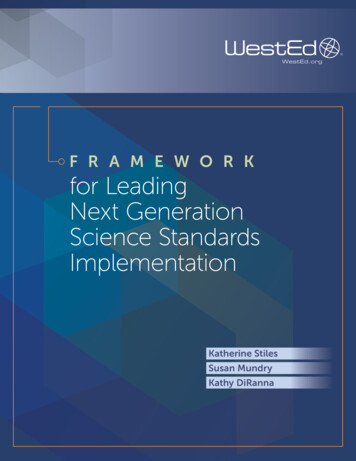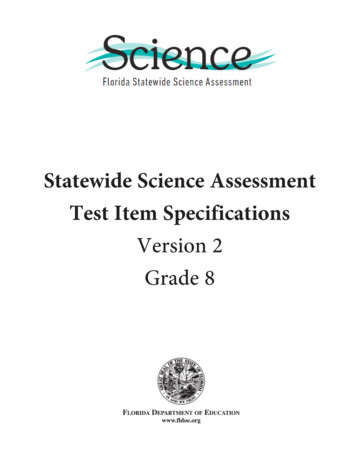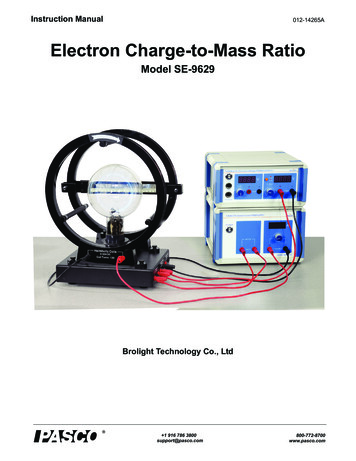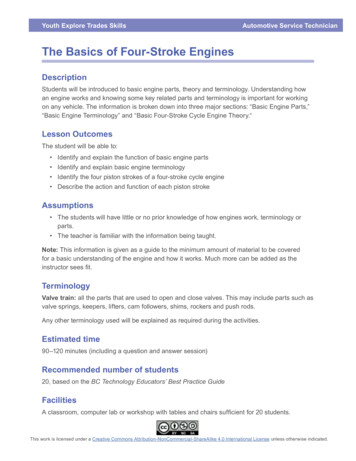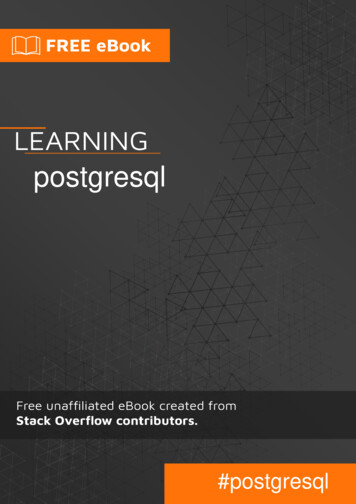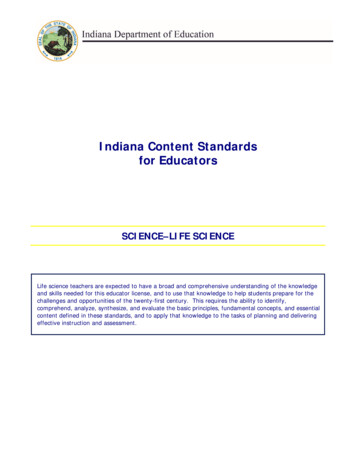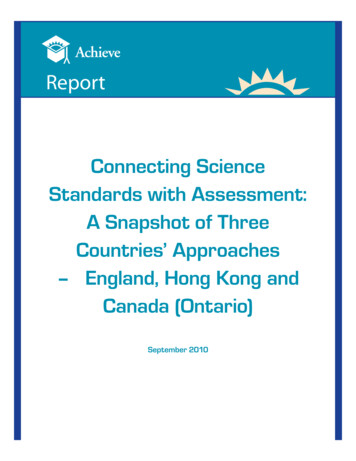
Transcription
policy briefReportConnecting ScienceStandards with Assessment:A Snapshot of ThreeCountries’ Approaches– England, Hong Kong andCanada (Ontario)September 2010
Connecting Science Standards with Assessment: A Snapshot of ThreeCountries’ Approaches – England, Hong Kong and Canada (Ontario)IntroductionThe education community has known for some time that a powerful lever in improving studentachievement is putting into place an instructional system where the central components—academic standards, quality assessments, teacher education and professional development andinstructional materials are aligned. Implementation has trailed vision in the U.S., but there isnow renewed energy toward realizing the vision with the adoption, by a growing majority ofstates, of the Common Core State Standards in English language arts and mathematics. In fact,work has already begun on plans for states to collaborate on common assessments in thosesubjects.While the attention of policy leaders and the education community at-large has been focusedon English language arts and mathematics, calls for reform of science education have beenbuilding in intensity since the release of Rising Above the Gathering Storm in 2005 1 andbolstered by other related influential reports. Most recently, the Carnegie foundation gavefresh impetus to STEM reform when it published The Opportunity Equation in 2009 2 with thestated goal of having all students graduate from high school as STEM-capable and agreed tofund the National Research Council to develop a new conceptual framework for scienceeducation after which Achieve will lead the development of aligned next generation sciencestandards. The National Research Council (NRC), Council of Chief State School Officers (CCSSO),National Governor’s Association (NGA), American Association for the Advancement of Science(AAAS), the National Science Teachers Association (NSTA), and the Council of State ScienceSupervisors (CSSS), will be active in the development of the new standards.Few quarrel with the need to re-think science education. Science education in the United Stateshas a long history of standards characterized by shallow coverage, disconnected lists of topics,and too little attention to how understandings can be supported and scaffolded from grade tograde. In preparation for the development of the NRC conceptual framework and nextgeneration science standards, Achieve undertook a study of ten countries’ standards in a searchfor exemplary features and to identify the emphasis, on average, that countries give to majorcurriculum topics. In the process of examining these international standards and supportingdocuments, Achieve noted that a few countries took pains to underscore the connection of theirstandards to their assessments. Specifically, in this brief, Achieve looks at the links betweenstandards and assessments in three countries—England, Hong Kong and Canada (Ontario).Achieve, through support from the Noyce Foundation, examined ten sets of internationalstandards with the intent of informing the development of both the conceptual framework andnew U.S. science standards. Achieve selected countries based on their strong performance oninternational assessments and/or their economic, political, or cultural importance to the UnitedStates.1Rising Above the Gathering Storm: Energizing and Employing America for a Brighter Economic Future.Carnegie Corporation of New York and Institute for Advanced Study, The Opportunity Equation: TransformingMathematics and Science Education for Citizenship and the Global Economy e-summary/ 2Page 1 of 13 2010
Implications for StatesAs the movement toward enacting higher standards and more rigorous assessments becomesmore entrenched in the U.S., the demand for support from state education agencies (SEAs) bytheir local districts will only continue to grow. Certainly this proved to be the case when the NoChild Left Behind Act required states to implement science standards and assessments in 2007.It has been standard practice for SEAs to produce and post content descriptions on theirwebsites regarding statewide assessments. And it is also common for SEA staff to developinstructional frameworks and curricular materials to use for teacher professional developmentand to enrich lesson planning. In support of helping SEAs meet these on-going challenges, thisbrief offers a glimpse of other countries’ guidelines. The 10 countries Achieve examined in itsinternational benchmarking study take a variety of approaches to standards and assessments,but three countries’ efforts (England, Hong Kong and Canada 3) to connect their standards,assessments and instruction stand out. By underscoring the importance of connectivity, therespective policy leaders made an excellent decision, for this type of practice engenders trustand opens up communication channels. When curriculum and assessment experts, who havecomplementary skills, collaborate, it becomes feasible not only to develop assessments that arealigned to standards, but also stretch from formative classroom assessments to summative stateassessments. Without such collaboration, there are often disconnects between the intendedrigor and quality of the standards and enacted assessments.The practices that the three countries put in place are worthy of consideration by states. To beeffective, teachers must have a clear understanding about the content of the statewideassessment and how it relates to everyday instruction. Involving teachers in the process oflinking assessments to standards serves to deepen their understanding of the alignmentprocess, including the types of items required for rigorous assessment—especially thoserequired to evaluate higher-order thinking, inquiry and design skills. Experience has also shownthat engaging teachers in the process of constructing and scoring classroom and school-basedassessments is a powerful form of professional development that results in improving studentachievement. Thus it is worth the effort for SEAs to be as transparent as possible regarding theassessment to standards connection and develop models that districts can adopt and/or adapt.Thoughtfully developed, aligned models substantiate the connection and counteractimpressions that the statewide assessment is based on a hidden set of standards.In sum, SEAs go through extensive protocols to align assessment with standards that arenecessary to ensure a valid assessment instrument and to increase students’ opportunity tolearn the assessed material. With some extra effort, states can enhance this practice byinsisting upon collaboration between staff in charge of standards and curriculum and staff incharge of assessment. A unified effort ensures alignment and a clear message to allstakeholders as to content, rigor, and intent of both classroom and state assessments.3Canada is represented by standards from the Province of Ontario. Canada delegates responsibility for thedevelopment of standards to the provinces or territories so that like U.S. states, each province has its own set ofstandards. Ontario’s standards are clearly written and therefore are a good choice for comparison – throughout therest of this document references to Canada are referring to the Province of Ontario’s standards).Page 2 of 13 2010
Similarities and Differences Among Countries Assessment PracticesWhile a thorough description of each country’s assessment system is beyond the scope of thisbrief, what follows is some helpful context for the examples we feature.In two of the countries, England and Hong Kong, decisions about education goals, content of thecurriculum, and formal assessments are made by a national governing authority. England andHong Kong both have national curricula and a system of national, high-stakes secondaryassessments to help ensure rigor and transparency. England publishes its secondaryexaminations online, while Hong Kong does not—although candidates are able to purchasesubject examination reports and question papers. Despite having strong central educationagencies, both countries allow and encourage localities and schools to assume someresponsibility for making curricular decisions.Canada is similar to the United States in that the education decision-making authority isreserved for each of Canada’s 13 jurisdictions (10 provinces and three territories), 4 including thedevelopment of standards and curricula. Thus, Canada’s national standards are used as the basisfor provinces developing their own standards—a situation reminiscent of states modeling theirscience standards on the NRC’s National Science Education Standards. Canada has a nationalassessment in language arts, math and science, the Pan-Canadian Assessment (PCAP) that issimilar to PISA (in which Canada also participates) in that it targets one content area eachtesting round and is not a high-stake assessment. Unlike PISA, which assesses 15 year-olds, PCAPis administered to a sample of 13 and 16 year olds. Some provinces, such as Alberta andOntario, administer their own exams based on their own standards and require these forgraduation. In recent years, the provinces and territories have come together under an umbrellaorganization, the Council of Ministers of Education (CMEC), to foster cooperation on issues ofcommon concern. Currently, there is no move toward national education standards.One concern that is common to the three countries is an expressed interest in providing formore in-depth study and assessment of key abilities. For example, England’s recent report onScience and Mathematics Secondary Education for the 21st Century includes as one of itsrecommendations: The style of examinations should be re-balanced towards assessment ofstudents’ in-depth problem solving and deeper understanding of subject concepts; and thereshould be greater emphasis on the accurate use of the English language in answers toexamination questions. 5 Hong Kong re-vamped science education in its primary schools in 2004with the intent of promoting creativity through hands-on, minds-on learning experiences andproblem-solving processes and by emphasizing inquiry and learning to learn skills. They furtherencouraged the shift by putting laboratories or activity rooms for science in primary schools.Reforms were extended to Lower Secondary schools and significant changes occurred at UpperSecondary with the introduction of school-based assessment to reduce the pressure of onehigh-stakes exam. 6 Hong Kong‘s curriculum unit topics for Upper Secondary courses aredescribed as Compulsory (for example, Cells and Molecules of Life) or Elective (for example,Biotechnology) to support extended investigations. Canada, by virtue of the emphasis on4International Review of Curriculum and Assessment Frameworks Internet Achieve. 2007. Education Around theWorld: Canada http://www.inca.org.uk/1205.html 5Science and Mathematics Secondary Education for the 21st Century: Report of the Science and Learning Expert Group.February 2010. p. 136Alice Siu Ling Wong and Benny Hin Wai Yung. The University of Hong Kong. Science Education and Science TeacherEducation in Hong Kong. Power Point Presentation.Page 3 of 13 2010
investigation and design that permeates its Science and technology standards, makes its goal inthis regard, absolutely clear.All three countries share an interest in making the role of formative assessment more central intheir systems. Ontario, in developing detailed rubrics supported by student work, best capturesthe potential power of thoughtfully developed classroom and/or school-based assessment toraise student achievement. A capsule summary of each country’s effort to realize andcommunicate the connection between its standards and assessments follows below.EnglandEngland sets forth its statuary requirements that schools must meet in relation to the nationalcurriculum by defining key stages and aligned programmes of study that describe what must betaught within a key stage. 7 However, the National Curriculum is not meant to be fullyprescriptive, but rather provides flexibility for schools to adapt the curriculum to their needs. 8 Atthe secondary level England has national examinations that are the main route to highereducation and may be required for some jobs. General Certificate of Secondary Education testsare taken by pupils of school leaving age. In science, at the end of Grade 9, most students takeScience A. This award, along with a second assessment, Additional Science, allows progression topost-16 science courses. These more rigorous science examinations, i.e., General Certificate ofEducation subject-based tests (A Levels, short for Advanced levels) are mostly taken by studentsaged 16-19. In science these include Biology, Chemistry and Physics.England specifies a set of attainment targets that link the key stages and programmes of study,helping to ensure students are on track to pass the national assessments. These targetsdescribe, for students of different abilities and levels of maturity, the specific ways in whichpupils can be said to demonstrate the acquisition of knowledge, skills and understandings thatcorrespond to each key stage. Teachers are instructed that: In deciding on a pupil’s level ofattainment at the end of a key stage, teachers should judge which description best fits the pupil’sperformance. When doing so, each description should be considered alongside descriptions foradjacent level. 9The attainment targets are therefore intended to be specific criteria against which students’progress is to be assessed. An example of these can be seen in the following excerpt from anattainment target pertaining to materials and their properties and their relationship to Earth:Attainment Target 3: materials and their propertiesLevel 1Pupils know about a range of properties [for example, texture, appearance] and communicateobservations of materials in terms of these properties.Level 2Pupils identify a range of common materials and know about some of their properties. Theydescribe similarities and differences between materials. They sort materials into groups anddescribe the basis for their groupings in everyday terms [for example, shininess, hardness,smoothness]. They describe ways in which some materials are changed by heating or cooling or7Science: The National Curriculum for England p.6 http://www.nc.uk.net National Curriculum Frequently asked questions (FAQs) http://www.nc.uk.net 9Science The National Curriculum for England, p. 74. Crown copyright 1999 http://www.nc.uk.net 8Page 4 of 13 2010
by processes such as bending or stretching.Level 3Pupils use their knowledge and understanding of materials when they describe a variety of waysof sorting them into groups according to their properties. They explain simply why somematerials are particularly suitable for specific purposes [for example, glass for windows, copperfor electrical cables]. They recognise that some changes [for example, the freezing of water] canbe reversed and some [for example, the baking of clay] cannot, and they classify changes in thisway.Level 4Pupils demonstrate knowledge and understanding of materials and their properties drawn fromthe key stage 2 or key stage 3 programme of study. They describe differences between theproperties of different materials and explain how these differences are used to classifysubstances [for example, as solids, liquids, gases at key stage 2, as acids, alkalis at key stage 3].They describe some methods [for example, filtration, distillation] that are used to separatesimple mixtures. They use scientific terms [for example, evaporation, condensation] to describechanges. They use knowledge about some reversible and irreversible changes to make simplepredictions about whether other changes are reversible or not.Level 5Pupils demonstrate an increasing knowledge and understanding of materials and theirproperties drawn from the key stage 2 or key stage 3 programme of study. They describe somemetallic properties [for example, good electrical conductivity] and use these properties todistinguish metals from other solids. They identify a range of contexts in which changes [forexample, evaporation, condensation] take place. They use knowledge about how a specificmixture [for example, salt and water, sand and water] can be separated to suggest ways inwhich other similar mixtures might be separated.Level 6Pupils use knowledge and understanding of the nature and behaviour of materials drawn fromthe key stage 3 programme of study to describe chemical and physical changes, and how newmaterials can be made. They recognise that matter is made up of particles, and describedifferences between the arrangement and movement of particles in solids, liquids and gases.They identify and describe similarities between some chemical reactions [for example, thereactions of acids with metals, the reactions of a variety of substances with oxygen]. They useword equations to summarise simple reactions. They relate changes of state to energy transfersin a range of contexts [for example, the formation of igneous rocks].Level 7Pupils use knowledge and understanding drawn from the key stage 3 programme of study tomake links between the nature and behaviour of materials and the particles of which they arecomposed. They use the particle model of matter in explanations of phenomena [for example,changes of state]. They explain differences between elements, compounds and mixtures interms of their constituent particles. They recognise that elements and compounds can berepresented by symbols and formulae. They apply their knowledge of physical and chemicalprocesses to explain the behaviour of materials in a variety of contexts [for example, the way inwhich natural limestone is changed through the action of rainwater, ways in which rocks areweathered]. They use patterns of reactivity [for example, those associated with a reactivityseries of metals] to make predictions about other chemical reactions.Level 8Pupils demonstrate an extensive knowledge and understanding drawn from the key stage 3programme of study, which they use to describe and explain the behaviour of, and changes to,Page 5 of 13 2010
materials. They use the particle model in a wide range of contexts. They describe what happensin a range of chemical reactions and classify some [for example, oxidation, neutralisation]. Theyrepresent common compounds by chemical formulae and use these formulae to form balancedsymbol equations for reactions [for example, those of acids with metals, carbonates or oxides].They apply their knowledge of patterns in chemical reactions to suggest how substances [forexample, salts] could be made.Exceptional performancePupils demonstrate both breadth and depth of knowledge and understanding drawn from thekey stage 3 programme of study when they describe and explain the nature and behaviour ofmaterials. They use particle theory in a wider range of contexts, recognising that differences inthe properties of materials relate to the nature of the particles within them. They recognise, andgive explanations for, examples of chemical behaviour that do not fit expected patterns. Theyroutinely use balanced symbol equations for reactions. They interpret quantitative data aboutchemical reactions, suggesting explanations for patterns identified.As can be observed in the example, the targets are formulated in terms of the types of evidencethat can be referenced in determining the level that each pupil has attained, making assessmentin effect an intrinsic part of the standard.Hong KongHong Kong offers a somewhat contrasting perspective on connecting standards to assessment.The standards for Primary through Lower Secondary are embedded in a Curriculum Guide thatincludes a full chapter on assessment. The standards for Upper Secondary, entitled Curriculumand Assessment Guides, are specific to each science discipline, and the discussion ofassessments permeates the entire document. A few comments regarding Hong Kong’sphilosophy and structure of its overall assessment system sets a context for the specific exampledescribed below.The Guides all emphasize the importance of formative assessment and its critical role in helpingstudents understand how to plan and take control of their learning and note that summativeassessment should not be used as the only means of assessment. 10 Hong Kong guidelines stressthat schools should use a variety of assessment including oral questioning, practical work andscientific investigations, written tests and projects. In Upper Secondary, summative publicassessment, which includes public examinations and moderated school-based assessments 11,come to the fore. The Hong Kong Diploma of Secondary Education provides a common end-ofschool credential that gives access to university study, work, and further education and training.Hong Kong’s curricular documents discuss a wide range of types of evidence that should becollected to verify student’s attainment of specific learning targets. For example, with respect toMicrobiology in secondary school: 1210Science Education Key Learning Area Curriculum Guide (Primary 1-Secondary 3) 2002, pp. 55-56.HKEAA has adopted an SBA Moderation Mechanism to adjust SBA marks submitted by schools to iron out possibledifferences across schools in marking standards.12Biology Curriculum and Assessment Guide (Secondary 4-6). 2007. pg. 54.11Page 6 of 13 2010
Students should learna. MicrobiologyViruses Multiplication of virusesStudents should be able to Describe how a virus reproduces by infecting aliving cell.Diversity of microorganisms Representative organisms of Bacteria, Protistaand FungiGrowth of microorganisms (e.g. yeast) Growth requirement Temperature, pH, carbon and nitrogensources, oxygen and water availability Stages of growth Measurement of growth Cell counts, biomass and optical methods Distinguish different groups ofmicroorganisms based on group features. Discuss the effects of environmental factorson the growth of microorganisms. Measure and identify the different stages ofgrowth of microorganisms in culture. Outline the principle of aseptic techniques. Use aseptic techniques and follow safetyprocedures in handling, culturing anddisposing of microorganisms.This example is typical of the entire standards document – all learning targets are presentedalong with a specification of the types of things students should be able to do that demonstratetheir attainment of these goals.Canada (Ontario)In Ontario, an important priority in their standards is “to promote greater consistency in theassessment of student work across the province.” 13 But the approach is different – rather thanonly describing criteria for determining the level of attainment of pupils or detailingspecifications of the measurement standards, Ontario has designed a set of assessment tasksand scoring rubrics, and collected and published samples of actual student work. These areregarded as illustrations of the types of skills and knowledge that students should give evidenceof as verification of their attainment of various levels of proficiencies associated with Ontario’sgoals.The tasks are described in detail, including the types of measures that they are intended toprovide, and then the rubrics are also detailed. Proficiency levels are tied to each one of theserubrics, and finally, two examples of genuine student work, associated with each one of theproficiency levels, are provided as illustrations. Each example is discussed and linked to both therubric and the original description of the proficiency levels. Below is an example:MAKING A TOYThe TaskStudents were asked to build a toy for a young child incorporating mechanisms and simplemachines. Specifically they were to: clarify the problem; brainstorm some possible solutions; draw design sketches for three of the solutions;13The Ontario Curriculum - Exemplars, Grades 1 and 2; Science and Technology. P. 58Page 7 of 13 2010
choose one sketch as their plan;design and build a model;test the model and make any necessary changes;reflect on their learning.ExpectationsThis task gave students the opportunity to demonstrate their achievement of all or part of eachof the following selected overall and specific expectations from the strand Structures andmechanisms; Grade 2 – MovementStudents will:1. Describe the position and movement of objects, and demonstrate an understanding ofhow simple mechanisms enable an object to move;2. Design and make simple mechanisms, and investigate their characteristics;3. Recognize that different mechanisms an systems move in different ways, and that thedifferent types of movement determine the design and method of production of thesemechanisms and systems;4. Ask questions about and identify needs or problems related to structures anmechanisms, and explore possible answers and solutions;5. Plan investigations to answer some of these questions or solve some of these problems,and describe the steps involved;6. Communicate the procedures and results of investigations and explorations for specificpurposes, using drawings, demonstrations, and oral and written description.Prior Knowledge and SkillsTo complete this task, students are expected to have some knowledge or skills related to thefollowing: attaching axles and wheels making hinges and other simple linkages recognizing different simple machines using a design-process model connecting parts to create movement in different ways and directionsTask Rubric – Grade 2: Making a ToyExpectationsUnderstandingof BasicConceptsDesign SkillsIdentifying theproblem/needLevel 1The student:Level 2Level 3Demonstrateslimitedunderstanding ofhow mechanismsenable movementand changes indirectionDemonstratessomeunderstanding ofhow mechanismsenable movementand changes indirectionDemonstratesgeneralunderstanding ofhow mechanismsenablemovement andchanges indirectionDemonstratesthoroughunderstanding ofhow mechanismsenable movementand changes indirectionThe student:Describes withlimited clarity thechallenge ofDescribes withsome clarity thechallenge ofClearly describesthe challenge ofdesigning andPrecisely describesthe challenge ofdesigning andPage 8 of 13Level 4 2010
ExpectationsMaking the planExecuting andevaluating theplanLevel 1designing andbuilding a model ofa toy incorporatingsimple machinesLists a few of thesteps needed toexecute the planLevel 2designing andbuilding a model ofa toy incorporatingsimple machinesLists some of thesteps needed toexecute the planCreates a minimallylabeled planMakes a fewmodifications tothe plan as neededCreates a partiallyCreates a fullylabeled planlabeled planMakes someMakesmodifications toappropriatethe plan as needed modifications tothe plan asneeded, givingreasons for themodificationsCreates a modelCreates a modelthat resembles the that resemblesplan to somethe plan includingextentmost recordedmodificationsCreates a modelthat resembles theplan to a limitedextentMakes limitedimprovements tothe modelCommunicationof RequiredKnowledgeLevel 3building a modelof a toyincorporatingsimple machinesLists most of thesteps needed toexecute the planMakes someimprovements tothe modelMakesconsiderableimprovements tothe modelMakes limited useof appropriatescience andtechnologyvocabulary todescribe simplemachines and theirmechanismsMakes some use ofappropriatescience andtechnologyvocabulary todescribe simplemachines and theirmechanismsExplains withlimited clarity howthe mechanism orsimple machine isused to createmovement,including changesin speed anddirectionProvides a simpleExplains with someclarity how themechanism orsimple machine isused to createmovement,including changesin speed anddirectionProvides aMakes generaluse ofappropriatescience andtechnologyvocabulary todescribe simplemachines andtheir mechanismsExplains clearlyhow themechanism orsimple machine isused to createmovement,including changesin speed anddirectionProvides a clearLevel 4building a model ofa toy incorporatingsimple machinesLists in a detailedmanner all or almostall of the stepsneeded to executethe planCreates a detailed,fully labeled planMakes appropriate,detailedmodifications to theplan as needed,giving reasons forthe modificationsCreates a modelthat resembles theplan to a limitedextent includingmost or almost allrecordedmodificationsMakes insightfulimprovements tothe modelThe student:Page 9 of 13Makes extensive useof appropriatescience andtechnologyvocabulary todescribe simplemachines and theirmechanismsExplains preciselyhow the mechanismor simple machine isused to createmovement,including changes inspeed and directionProvides a complex 2010
ExpectationsRelating ofScience andTechnology toeach other andto the worldoutside theschoolLevel 1explanation of howthe toy could beused to improvefine-motor skillsLevel 2somewhat clearexplanation of howthe toy could beused to improvefine-motor skillsLevel 3explanation ofhow the toy couldbe used toimprove finemotor skillsLevel 4and detailedexplanation of howthe toy could beused to improvefine-motor skillsDescribes in somedetail similaritiesbetween themodel andmechanisms andsimple machines inreal-life objectsDescribes indetail similaritiesbetween themodel andmechanisms andsimple machinesin real-life objectsDescribes in richdetail similaritiesbetween the modeland mechanismsand simplemachines in real-lifeobjectsThe student:Describes in limiteddetail similaritiesbetween the modeland mechanismsand simplemachines in reallife objectsFollowing is a sample of a Grade 2 student’s work assessed as Level 3, along with Teacher’sNotes that explain the evaluation. 1414Adapted from The Ontario Curriculum – Exemplars Grades 1 and 2: Science and Technology 2002. Grade 2Structures and Mechanisms – Making a Toy: Level 3, Sample 2 pgs entary/scientec12ex/scien2 3.pdfPage 10 of 13 2010
Page 11 of 13 2010
Page 12
building in intensity since the release of Rising Above the Gathering Storm in 2005. 1. and bolstered by other related influential reports. Most recently, the Carnegie foundation gave fresh impetus to STEM reform when it published . The Opportunity Equation. in 2009. 2.
